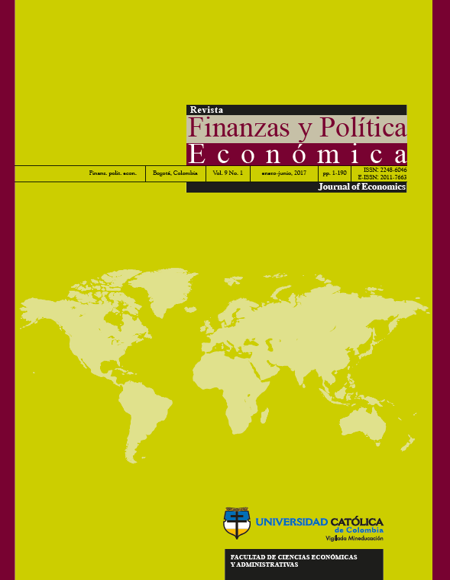
This work is licensed under a Creative Commons Attribution-NonCommercial-ShareAlike 4.0 International License.
This journal is licensed by a Creative Commons Attribution License (CC BY-NC-SA 4.0) Attribution-Non Commercial 4.0 International. For the CC licenses, the principle isthe creative freedom. This system complements the copyright without opposing it, conscious of its importance in our culture. The content of the articles is the responsibility of each author, and does not compromise in any way, to the journal or the university. It allows the transmission and reproduction of titles, abstracts and full content, with academic, scientific, cultural ends, provided acknowledgment of the respective source. This work cannot be used for commercial purposes.
They journal does not charge authors for submission or publication.
Abstract
The sanctioning process for environmental infringement in Colombia includes the exercise of determining fines (Law 1333 of 2009), with a methodology established in the Resolution 2086 of 2010, and proposed by the Ministry of Environment, Housing, and Territorial Development (MAVDT for its initials in Spanish) in 2010. Nevertheless, despite the fact that there exists an approved and published determination methodology, its implementation by different public institutions that exercise environmental authority in the country is not clear, mainly due to the fact that such methodology contains details in the writing that do not facilitate the understanding of the procedure in important sections. This article aims to establish conceptual foundations for the determination of fines according to the methodology approved in Colombia, as well as to present in an explicit and clear manner each formula that is necessary in the determination process, so that determination criteria used by specialized personnel match the standards. The basis of the discussion is to consider fine as the sum of illicit benefits and environmental damage, whether the latter is real or potential. The paper concludes that the formula for the determination of fines for environmental infringement in Colombia is adequate for the sanctioning processes that take place in the country.

References
Cafferatta, N. (2004). Introducción al derecho ambiental. Bogotá: Instituto Nacional de Ecología.
Cafferatta, N. (2010). La responsabilidad por daño ambiental. En Memorias del V Programa Regional de Capacitación en Derecho y Políticas Ambientales. Bogotá: PNUD.
Congreso de la República de Colombia (2009, 21 de julio). Ley 1333 del 2009, por la cual se establece el procedimiento sancionatorio ambiental y se dictan otras disposiciones. Diario Oficial 47.417.
Delgado, W. (2015) Gestión y valor económico del recurso hídrico. Revista Finanzas y Política Económica, 7(2), 279-298. https://doi.org/10.14718/revfinanzpolitecon.2015.7.2.4
Garro, A. (2016). Principio de proporcionalidad como límite de material para la imposición de la medida preventiva en materia ambiental de suspensión de obra, proyecto o actividad. Revista de la Facultad de Derecho y Ciencias Políticas, 46(125), 443-468. https://doi.org/10.18566/rfdcp.v46n125.a09
Ministerio de Ambiente Vivienda y Desarrollo Territorial (MAVDT) (2010). Metodología para el cálculo de multas por infracción a la normatividad ambiental. Manual conceptual y procedimental. Bogotá: Autor.
Ministerio de Ambiente y Desarrollo Territorial de Colombia (2010, 4 de octubre). Decreto 3678 de 2010, por el cual se establecen los criterios para la imposición de las sanciones consagradas en el artículo 40 de la Ley 1333 del 21 de julio de 2009 y se toman otras determinaciones. Diario Oficial 47.4174.
Ministerio de Ambiente y Desarrollo Territorial de Colombia (2010, 25 de octubre). Resolución 2086 de 2010, por la cual se adopta la metodología para la tasación de multas consagradas en el numeral 1° del artículo 40 de la Ley 1333 del 21 de julio del 2009 y se toman otras determinaciones. Diario Oficial 47.876.
Organismo de Evaluación y Fiscalización Ambiental (OEFA) (2012). Metodología para el cálculo de las multas base y la aplicación de los factores agravantes y atenuantes a utilizar en la graduación de sanciones. Lima: Autor.
Olarte-Rivera, F. (2017). Breve estudio descriptivo de los daños ambientales. DIXI, Derecho y Políticas Públicas, 19(25), 83-103. https://doi.org/10.16925/di.v19i25.1823
Peña, C. (2013). Daño ambiental y prescripción. Revista Judicial, 109, 117-143.
Toro, J., Prada, R. y Arrieta, G. (2013). Métodos de evaluación de impacto ambiental en Colombia. Revista de Investigación Agraria y Ambiental, 4(2), 43-53. https://doi.org/10.22490/21456453.990





























